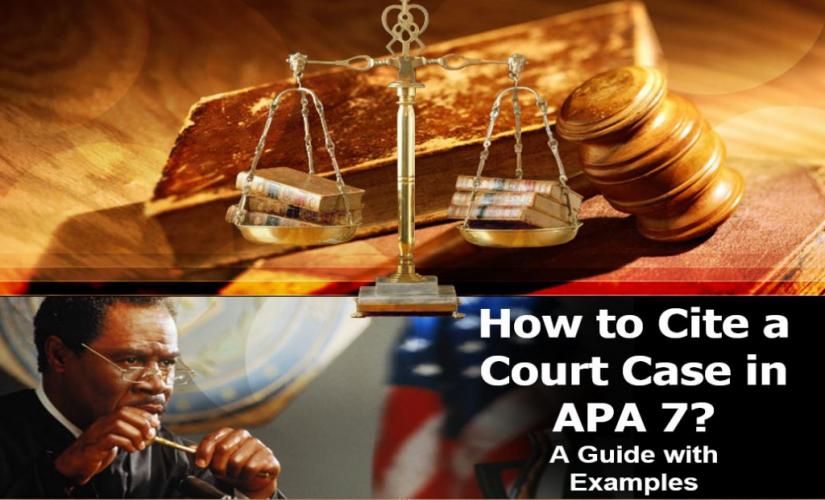Courts play a fundamental role in the justice system as they enable law and order in society. For example, the primary obligation of judges and magistrates is to listen to criminal and civil cases brought before them and make rulings. Basically, a court case entails a dispute between two parties, where one (the plaintiff) takes another (the defendant) to court for causing them harm. Also, many students use the APA format to cite court cases. In turn, by considering a criminal case, the harm involves violating the established laws. When citing a court case in APA, a researcher should capture the core components, which include: the case title, the year when the ruling was made, the reporter, including the volume number and the first-page number, and the jurisdiction. Hence, students need to learn how to cite a court case in APA to provide high-quality papers. This skill is particularly useful for mastering objective writing in academic contexts
General Aspects of Referencing a Court Case in APA 7
The objective of the justice system is to ensure law and order prevails in society. As a vital component of the system, courts play a significant role in enabling this society by making decisions on cases before them. Basically, these decisions come in the form of rulings, including sentences for those found guilty of criminal and civil offenses. Therefore, a court case is a legal process that entails a conflict between two parties, where one accuses the other of gross violation of terms of the contract. This highlights the importance of mastering apa citation court case guidelines. In a criminal case, the contract is the law of the land, while in civil cases, the agreement may be a relation of some kind, such as an employment contract. Hence, scholars cite a court case in APA for educational and academic purposes.

Citing Criminal and Civil Cases in APA 7
Rulings in criminal cases in APA entail the enforcement of codes of behavior, as codified in established laws. Basically, criminal cases involve the state prosecuting individuals for violating those laws, and it is a commitment of a crime. For example, common rulings by courts are fines, community service, probation, and jail time. In contrast, civil cases entail the resolution of conflicts between people and institutions. Moreover, these cases in APA involve one person or business (the plaintiff), claiming that another (the defendant) has caused them harm. Therefore, the court case is the plaintiff asking the court for relief in the form of damages (monetary compensation) or an injunction. This process often aligns with principles found in examples of objective writing In turn, the latter involves stopping the defendant from doing something or requiring them to do something. Also, it involves a declaratory judgment, where the court determines the rights of each party as spelled out in a contract or statute.
Reference Components of a Court Case in APA
Typically, citing a court case in APA entails the following core elements:
- The title of the case.
- The year of the ruling.
- The volume number.
- An abbreviation of the reporter.
- The first-page number.
- Abbreviation of the jurisdiction.
Citing a Court Case
When writing academic texts, such as essays, theses, and dissertations, students may have to reference a court case in APA to strengthen a claim, an observation, opinion, or argument. Hence, students need to learn how to cite a court case in all applicable formats. While citing components of a court case never change, the manner of citation changes as per each format – APA, MLA, Harvard, and Chicago/Turabian.
1. The Title of the Case
The title of a court case is the most prominent feature in a citation by considering APA. Basically, the title entails the names of parties in conflict, with an abbreviation of the word “versus” being used to separate them. Also, the name that appears first is the plaintiff’s, and the one that comes in second is that of the defendant. For example, in the court case, Roe v. Wade, Jane Roe is the plaintiff, and Henry Wade, who is the district attorney of Dallas County in Texas, is the defendant. When citing a court case in APA, the most common places where a student can access the case title are court records, the Supreme Court website (for federal cases), the Law Congress Library, the media, and government websites, such as justice.gov and archives.gov.
2. The Year of the Ruling
The year when the court ruled on the case is the second feature that appears in a court case citation. While court cases are not a one-day event, the most crucial thing in indicating its lifetime is capturing the date when the court makes its ruling. Basically, law cases may take several years to reach its conclusions, and the only time that history will remember such conflicts is the day when courts make its decision on the matter before it. When citing a court case in APA, a student can find the date by locating the title in court records, the media, and government websites, such as justice.gov and archives.gov.
3. The Volume Number
The volume number is the third feature that appears in a citation of a court case in APA. Basically, this feature serves the purpose of locating the case in the reporter. Moreover, it serves the same meaning as the volume number of a journal article – helping a student or researcher to find an item in a database. Since rulings on court cases are legal documents, the justice system ensures that they are captured in essential repositories, with the volume number acting as an identifier. Hence, a researcher can access the volume number of a case by searching for the case title in court records and government websites, like justice.gov and archives.gov.
4. An Abbreviation of the Reporter
The abbreviated name of the reporter is the fourth feature in a court case citation for APA. Basically, the reporter is the publisher that captures court cases chronologically. Moreover, reporters can be official and unofficial. For example, the former entails publications approved by the government to reproduce the reported cases within a jurisdiction, while the latter involves commercial publishers who reproduce the reported cases within a jurisdiction. However, a court case citation in APA should capture the name of the official reporter, which researchers can access by searching for the case title in court records and government websites, such as justice.gov and archives.gov.
5. The First-Page Number
The first-page number is the fifth feature that appears in a court case citation for APA. Like a journal article, the page number of a court case indicates the location of the case in the reporter. As such, it is closely related to the volume number. However, while the volume number gives a general idea about the location of the court case in the reporter, the page number is specific about the same. When citing a court case in APA, researchers can identify the first-page number by searching for the case title in court records and government websites, such as justice.gov and archives.gov.
6. Abbreviation of the Jurisdiction
Court cases are limited in a jurisdiction, meaning that they resolve conflicts between parties in a specific location. Basically, this location can be a country or state in the case of nations like the US with two forms of government. Although famous cases may not indicate the jurisdiction when captured in media and other platforms, researchers must identify the feature in a citation. To access the jurisdiction of the case, they can locate the case title in court records and government websites, such as justice.gov and archives.gov.
The Reference Scheme for a Court Case in APA
The scheme of a citation denotes the format in which all the core elements appear. As discussed earlier, a court case citation in APA has several components that help researchers locate information about the case. In this regard, the structure of the citation should read as follows:
Citation Structure for a Court Case in APA:
Case title (in italics) the year (in square brackets for volume numbers or parentheses or “round brackets” for volume only ) the volume number the abbreviated name of the reporter the first-page number the abbreviated name of the jurisdiction (in parentheses). Retrieved from link (if available)
Examples of Citing Court Cases in APA
- Minister for Immigration and Border Protection v. Kumar [2017] HCA 11(Austl.). Retrieved from http://eresources.hcourt.gov.au/downloadPdf/2017/HCA/11
- Barnes v. Yahoo Inc. [2009] 570 F.3d 1096 (9th Cir.). Retrieved from https://www.lawpipe.com/U.S.-Federal-Courts/Barnes_v_Yahoo_Inc.html
- Sunset Harbour Condominium v. Robbins [2005] 914 So. 2d 925 (Fla.)
Note: if reporters are organized by volume, researchers need to highlight the year by “()” instead of “[].”
1. Explanation of the First Example of a Reference
Looking at the three examples above, one can notice that APA reference citations are different in terms of information captured. In the first example, the plaintiff is the Minister for Immigration and Border Protection, and the defendant is Yogesh Kumar, thus the arrangement of the names in the title. As indicated in the introduction, the first name that appears in a case title is that of the plaintiff. Moreover, the Minister for Immigration and Border Protection was suing Kumar. When citing a court case in APA, the title captures the surname of parties if they are individuals. Then, the court made its ruling in 2017, recorded in the reporter High Court of Australia abbreviated as HCA. Since only the first-page number is indicated, it means the publication had no volume number. In turn, the case happened in Australia, which is the abbreviated jurisdiction.
2. Explanation of the Second Example a Reference
In the second example, the plaintiff is Cecilia Barnes and the defendant is Yahoo! The court made its ruling in 2005, which is documented in the Federal Reporter abbreviated as F.3d. the publication’s volume number is 570, and the first-page number is 1096. Also, the 9th Circuit of the Federal Court, which has jurisdiction in several states (including Alaska, Arizona, and California), made the ruling.
3. Explanation of the Third Example a Reference
In the third example, the plaintiff is Sunset Harbour Condominium, and the defendant is Joel Robbins, where the court made a ruling in 2005. Firstly, the verdict is documented in the case reporter Southern Reporter Second, abbreviated as So. 2d. In turn, the volume number of the publication is 914, and the first-page number is 925. The ruling was made in the jurisdiction of Florida State.
Summing Up on How to Cite a Court Case in APA 7
When writing academic texts, such as essays, theses, and dissertations, students cite different sources to back up their ideas, opinions, and arguments. Basically, a court case is a legal process involving two parties, such as the plaintiff and the defendant. Basically, this process culminates in a ruling by the court. Moreover, when citing a court case in APA, a researcher must be sure to capture all the core elements, which are: the case title, the year when the ruling is made, the reporter, including the volume number and the first-page number, and the jurisdiction.
In summary, the following tips are essential when citing a court case in APA:
- Identify the parties – the plaintiff and the defendant.
- The year when the court made the final ruling.
- The reporter that has documented the decision.
- The legal jurisdiction of the ruling.


